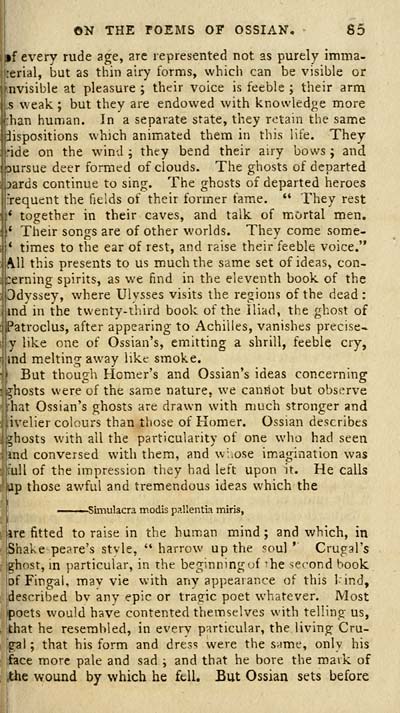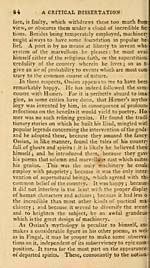Download files
Complete book:
Individual page:
Thumbnail gallery: Grid view | List view

ON THE FOEMS OF OSSIAN. 85
:if every rude age, are represented not as purely imma-
:erial, but as thin airy forms, which can be visible or
nvisible at pleasure ; their voice is feeble ; their arm
s V. eak ; but they are endowed with knowledge more
li:ir. human. In a separate state, they retain the same
jupositions which animated them in this life. They
■icie on the wind ; they bend their airy bows ; and
3ursue deer formed of clouds. The ghosts of departed
jarus continue to sing. The ghosts of departed heroes
Vequcnt the fields of their former fame. " They rest
* t leether in their caves, and talk of mortal men.
' i'lieir songs are of other worlds. They come some-
' times to the ear of rest, and raise their feeble voice."
All this presents to us much the same set of ideas, con-
L:erning spirits, as we find in the eleventh book of the
Ddyssey, where Ulvsses visits the regions of the dead:
md in the twenty-third book of the iliad, the ghost of
Patroclus, after appearing to Achilles, vanishes precise-
y like one of Ossian's, emitting a shrill, feeble cry,
md melting away hkc smoke.
But though Homer's and Ossian's ideas concerning
ghosts were of the same nature, we cannot but observe
•hat Ossian's ghosts are drawn with much stronger and
ivelier colours than those of Komer. Ossian describes
I ghosts with all the particularity of one who had seen
lind conversed with them, and whose imiagination was
iJull of the impression they had left upon it. He calls
'ap those awful and tremendous ideas which the
" Simulacra modis pp.llentia miris,
are fitted to raise in the human mind ; and which, in
Shake peare's stvle, " harrow up the soul ' Crugal's
sehost, in particular, in the beginning of 'he second book.
DfFingai, may vie with any appearance of this I-ind,
described bv any epic or traeic poet whatever. Most
ipoets would have contented themselves with telling us,
that he resembled, in every particular, the living Cru-
gal ; that his form and dress were the s-ime, only his
face more pale and sad ^ and that he bore the mark of
the wound by which he ftU. But Ossian sets before
:if every rude age, are represented not as purely imma-
:erial, but as thin airy forms, which can be visible or
nvisible at pleasure ; their voice is feeble ; their arm
s V. eak ; but they are endowed with knowledge more
li:ir. human. In a separate state, they retain the same
jupositions which animated them in this life. They
■icie on the wind ; they bend their airy bows ; and
3ursue deer formed of clouds. The ghosts of departed
jarus continue to sing. The ghosts of departed heroes
Vequcnt the fields of their former fame. " They rest
* t leether in their caves, and talk of mortal men.
' i'lieir songs are of other worlds. They come some-
' times to the ear of rest, and raise their feeble voice."
All this presents to us much the same set of ideas, con-
L:erning spirits, as we find in the eleventh book of the
Ddyssey, where Ulvsses visits the regions of the dead:
md in the twenty-third book of the iliad, the ghost of
Patroclus, after appearing to Achilles, vanishes precise-
y like one of Ossian's, emitting a shrill, feeble cry,
md melting away hkc smoke.
But though Homer's and Ossian's ideas concerning
ghosts were of the same nature, we cannot but observe
•hat Ossian's ghosts are drawn with much stronger and
ivelier colours than those of Komer. Ossian describes
I ghosts with all the particularity of one who had seen
lind conversed with them, and whose imiagination was
iJull of the impression they had left upon it. He calls
'ap those awful and tremendous ideas which the
" Simulacra modis pp.llentia miris,
are fitted to raise in the human mind ; and which, in
Shake peare's stvle, " harrow up the soul ' Crugal's
sehost, in particular, in the beginning of 'he second book.
DfFingai, may vie with any appearance of this I-ind,
described bv any epic or traeic poet whatever. Most
ipoets would have contented themselves with telling us,
that he resembled, in every particular, the living Cru-
gal ; that his form and dress were the s-ime, only his
face more pale and sad ^ and that he bore the mark of
the wound by which he ftU. But Ossian sets before
Set display mode to: Large image | Transcription
Images and transcriptions on this page, including medium image downloads, may be used under the Creative Commons Attribution 4.0 International Licence unless otherwise stated. ![]()
| Early Gaelic Book Collections > Ossian Collection > Poems of Ossian, the son of Fingal > (101) |
|---|
| Permanent URL | https://digital.nls.uk/77920260 |
|---|
| Description | Selected books from the Ossian Collection of 327 volumes, originally assembled by J. Norman Methven of Perth. Different editions and translations of James MacPherson's epic poem 'Ossian', some with a map of the 'Kingdom of Connor'. Also secondary material relating to Ossianic poetry and the Ossian controversy. |
|---|
| Description | Selected items from five 'Special and Named Printed Collections'. Includes books in Gaelic and other Celtic languages, works about the Gaels, their languages, literature, culture and history. |
|---|

